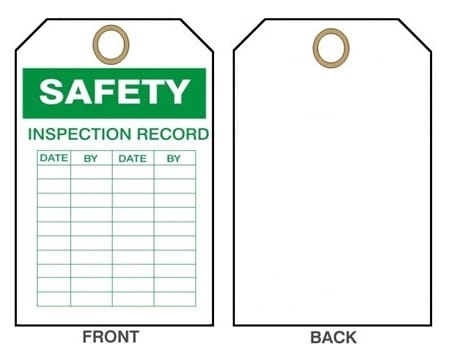Your Guide To Safety Inspection Tags
Inspection tags and equipment tags are essential to keeping your work environment safe, efficient and accident-free. They are a way to visually communicate workplace hazards and show that equipment has been inspected.
Within this guide we will cover the importance of safety inspection tags, the different types available as well as how to use them to keep your business operating smoothly.
What are safety inspection tags?
Ladder tags and scaffolding tags are types of safety inspection tags or signs that are attached to equipment to clearly indicate whether it is safe to use and so prevent accidents. They consist of a holder that permanently attaches to the equipment along with write-on inserts that can be slotted inside.
Usually, you will find these workplace safety tags are available to purchase as individual components sold in packs, or as inspection tag kits that come with both the holder and tags.
What are the benefits of safety inspection tags?
The main benefit of safety inspection tags is that they help to manage the identification, safety and maintenance of many applications and appliances within the workplace such as ladders and scaffolding.
They also help workplaces stay compliant with the relevant health and safety legislation such as the WAHR (Work at Height Regulations) 2005, where the risk of falling is liable to cause personal injury. Other benefits include:
- helping to ensure equipment and machines are running efficiently at all times.
- recording an audit trail of recent equipment maintenance, tests and inspections.
- communicating to workers when inspections have been most recently completed.
- providing cost-effective, strategic accident prevention.
What are the different types of safety inspection tags?
Lockout/do not operate tags: let other workers know that a machine is currently being serviced or repaired and that they should not try to turn it on.
Ladder and scaffold tags: act as inspection records and help to ensure that all ladder and scaffolding inspection procedures and maintenance are kept up to date.
Inspection tags: identify the piece of equipment and the location, as well as the date of each inspection and the name of the person who signed off on it. They can be used on equipment such as fire extinguishers and forklifts.
Machine tags: alert employees when a machine is not operating or should not be turned on for any reason to avoid injury to themselves or others in the area.
How to attach safety inspection tags
The holder part of the tag attaches to the equipment and the insert is placed in the holder and used to record and display the latest equipment status.
These work together in a looped process to provide up to date information to employees. To attach a tag, follow the steps below:
- Attach the empty holder that says, ‘DO NOT USE…’ and has the matching symbol to equipment.
- Make sure that the equipment is inspected periodically, as deemed appropriate by risk assessment, and the results recorded on the insert.
- Once the equipment passes inspection, place the updated insert in the holder to display the latest equipment information to users.
Important to note: if equipment fails inspection at any point, then simply remove the insert from the holder to display the ‘DO NOT USE…’ sign.



